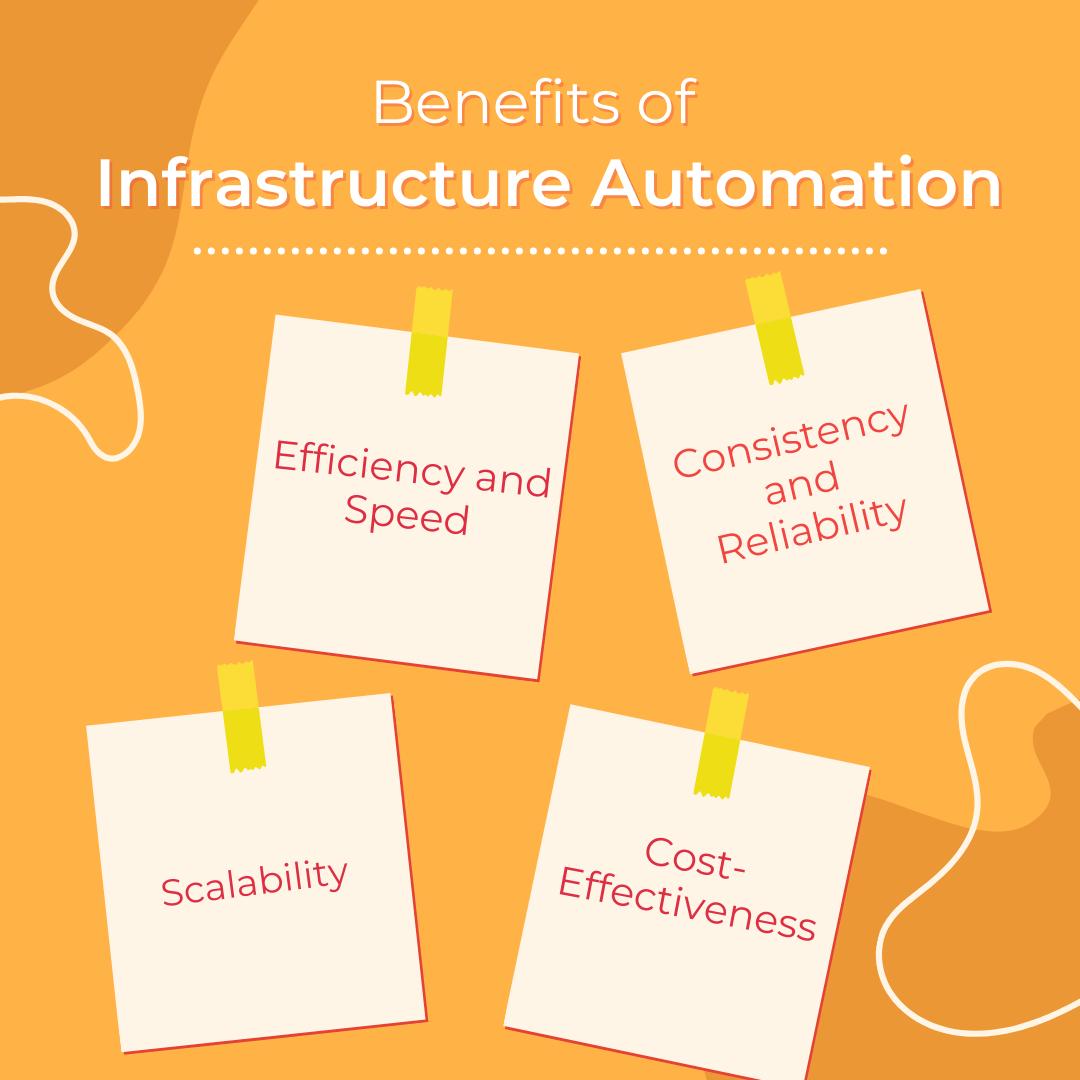Introduction
Manual management of IT infrastructure often leads to slow processes, frequent errors, and difficulties in scaling. These inefficiencies can hinder business growth and operational stability.
Infrastructure automation addresses these issues by automating repetitive tasks and optimizing resource management. This not only speeds up operations but also reduces errors and allows for easier scaling, providing a robust solution to modern IT challenges.
What is Infrastructure Automation?
Infrastructure automation involves leveraging technology to streamline IT infrastructure provisioning, management, and deployment. It involves replacing manual, repetitive tasks with automated processes, enabling organizations to efficiently handle and scale their IT resources. This approach reduces the need for human intervention and minimizes errors, leading to more reliable and consistent IT operations.
Core Components
- Configuration Management: This focuses on automating the setup and upkeep of system configurations. Tools like Ansible, Puppet, and Chef are commonly used to ensure that all systems are configured consistently and correctly, reducing configuration drift and manual errors.
- Orchestration: Orchestration streamlines the management and coordination of IT tasks and workflows through automation. Tools such as Kubernetes and Docker Swarm manage containerized applications, while Terraform is used for infrastructure provisioning across multiple environments. Orchestration ensures that different components of the IT infrastructure work together seamlessly.
- Provisioning: Provisioning streamlines the allocation and management of resources like virtual machines and storage through automation. Tools like AWS CloudFormation, Azure Resource Manager, and Google Cloud Deployment Manager enable the automated deployment of infrastructure resources, allowing for quicker and more scalable setups.
Importance in Modern IT
In today's fast-paced IT environment, manual management of infrastructure can be cumbersome and error-prone. Automation is crucial for enhancing agility and efficiency, allowing organizations to deploy, manage, and scale their infrastructure rapidly and reliably.
By leveraging automation, businesses can reduce operational overhead, improve consistency, and respond more quickly to changing demands and challenges. This capability is essential for maintaining competitiveness and operational excellence in the digital age.
Key Technologies and Tools in Infrastructure Automation
Configuration Management Tools
Configuration management tools streamline and automate the process of setting up and maintaining system configurations, ensuring consistency and efficiency. These tools ensure consistency across multiple systems, minimizing manual intervention and errors. Key tools in this category include:
- Ansible: A widely used open-source tool recognized for its straightforward and agentless design. It leverages YAML-based playbooks to outline automation tasks, offering a user-friendly and scalable solution for diverse environments.
- Puppet: This tool focuses on enforcing desired system states through its declarative language. Puppet is highly effective for managing large-scale infrastructures and seamlessly integrates with various tools and platforms.
- Chef: Chef uses a Ruby-based DSL to define configurations and automate infrastructure tasks. It is highly flexible and supports complex deployments, offering robust management capabilities for diverse environments.
Orchestration Tools
Orchestration tools manage and coordinate complex workflows and deployments, ensuring smooth operation of interconnected systems. Prominent tools include:
- Kubernetes: A robust open-source platform that automates containerized applications' deployment, scaling, and management. Its features, including self-healing and load balancing, enable seamless and efficient operations.
- Docker Swarm: Docker’s native clustering and orchestration tool, which simplifies container management and scaling within Docker environments. It is known for its ease of use and integration with Docker’s ecosystem.
- Terraform: A tool for infrastructure provisioning that uses a declarative language to manage cloud resources across various providers. Terraform enables infrastructure as code (IaC), allowing for consistent and repeatable deployments.
Provisioning Tools
Provisioning tools streamline the creation and management of infrastructure resources, allowing for rapid and scalable setups. Prominent tools in this space include:
- AWS CloudFormation: A service from Amazon that facilitates the design and deployment of AWS resources. Using JSON or YAML templates, it automates infrastructure provisioning and updates with ease and efficiency.
- Azure Resource Manager (ARM): Microsoft’s service for managing Azure resources through templates. ARM delivers an integrated management platform that ensures consistent deployment and administration of Azure resources.
- Google Cloud Deployment Manager: Google Cloud’s tool for defining and managing resources using YAML configurations. It supports complex deployments and integrates with other Google Cloud services, simplifying infrastructure management.
Benefits of Infrastructure Automation
Efficiency and Speed
Infrastructure automation significantly accelerates deployment processes by eliminating manual tasks and streamlining workflows. Automated systems can provision and configure resources in a fraction of the time it takes manually, leading to faster application rollouts and updates.
This speed enhances overall productivity and allows IT teams to focus on more strategic initiatives rather than repetitive, time-consuming tasks.
Consistency and Reliability
Automation guarantees consistent configuration and deployment of infrastructure across various environments. By using predefined scripts and templates, organizations can avoid discrepancies that arise from manual setups.
This consistency reduces the risk of errors and ensures that all environments—whether development, staging, or production—mirror each other accurately. Reliable, repeatable processes enhance system stability and performance.
Scalability
With infrastructure automation, scaling up or down becomes straightforward and efficient. Automated tools can manage resource allocation dynamically based on demand, allowing organizations to quickly adapt to changing workloads.
This flexibility supports business growth and ensures that resources are used optimally, without manual intervention to adjust infrastructure.
Cost-Effectiveness
Automating infrastructure management leads to significant cost savings. Reducing manual intervention helps organizations cut labor costs and decrease the likelihood of expensive mistakes. Additionally, automation optimizes resource usage, preventing over-provisioning and ensuring that resources are allocated efficiently.
This optimized approach to resource management translates into reduced operational expenses and improved budget management.

Challenges and Risks
Initial Setup Complexity
Implementing infrastructure automation can be complex and time-consuming, especially for organizations new to the technology. The initial setup often involves learning curves associated with selecting and configuring the right tools, developing scripts, and integrating automation into existing workflows.
This complexity can lead to potential delays and requires careful planning and expertise to ensure successful deployment.
Security Concerns
Automation introduces new security challenges that must be addressed to protect sensitive data and systems. Automated processes may inadvertently expose vulnerabilities if not properly configured. For instance, automated scripts and configurations need to be secured to prevent unauthorized access.
Additionally, automation tools themselves must be regularly updated to guard against emerging threats. Ensuring that security measures are integrated into automated workflows is crucial to mitigating risks.
Over-Automation
While automation can greatly enhance efficiency, there is a risk of over-relying on it, which can lead to problems if not managed properly. Over-automation may result in complex and rigid systems that are difficult to modify or troubleshoot.
Additionally, if automation processes fail or encounter issues, it can be challenging to diagnose and resolve problems quickly, especially if there is limited manual oversight. Striking the right balance between automation and manual intervention is essential to maintaining flexibility and control.
Best Practices in Implementing Infrastructure Automation
Start Small and Scale
When implementing infrastructure automation, it’s advisable to start with small, manageable tasks before expanding to more complex processes. Begin by automating simple, repetitive tasks to build familiarity and confidence with the tools and practices.
This gradual approach allows teams to refine their automation strategies and address any issues on a smaller scale before scaling up to broader and more critical infrastructure elements.
Documentation and Version Control
Proper documentation and version control are crucial for successful automation. Maintain detailed records of scripts, configurations, and workflows to ensure clarity and ease of management. Version control systems, such as Git, help track changes, manage updates, and collaborate effectively.
This practice not only aids in troubleshooting and audits but also ensures that teams can revert to previous versions if needed, maintaining stability and consistency in automated processes.
Monitoring and Logging
Robust monitoring and logging are essential for tracking automated processes and identifying potential issues early. Implement comprehensive monitoring solutions to oversee the performance and health of automated systems.
Logging provides a record of automation activities, which is invaluable for diagnosing problems, auditing operations, and ensuring compliance. Effective monitoring and logging practices help maintain visibility and control over automated environments, facilitating proactive management and quick resolution of issues.
Continuous Integration/Continuous Deployment (CI/CD)
Integrate automation with CI/CD pipelines to streamline and enhance the deployment process. CI/CD practices enable continuous integration of code changes and automated testing, ensuring that new features and updates are deployed efficiently and reliably.
By incorporating automation into CI/CD workflows, organizations can achieve faster and more consistent deployments, reduce manual errors, and accelerate the development lifecycle.
Case Studies and Real-Life Examples
Enterprise Case Study: Capital One
Capital One, a major financial institution, adopted infrastructure automation to streamline its IT operations and enhance its cloud capabilities. The company implemented Ansible for configuration management, Kubernetes for container orchestration, and Terraform for infrastructure provisioning.
This automation strategy allowed Capital One to accelerate its application deployment processes, achieve consistent configurations across environments, and rapidly scale its infrastructure to meet growing customer demands. As a result, the company improved operational efficiency, reduced manual errors, and enhanced its ability to innovate and respond to market changes quickly.
Small to Mid-Sized Business Example: DigitalOcean
DigitalOcean, a cloud infrastructure provider, serves as an excellent example of how a smaller company can leverage automation for growth and cost savings. The company utilized Docker Swarm for container orchestration and AWS CloudFormation for provisioning resources. By automating infrastructure management, DigitalOcean significantly reduced the time required for provisioning and scaling cloud resources.
This efficiency enabled the company to handle surges in traffic and demand without manual intervention. The automation of repetitive tasks also led to substantial cost savings by optimizing resource allocation and minimizing the need for manual oversight. This strategic use of automation played a crucial role in DigitalOcean’s ability to scale effectively and offer competitive cloud solutions.
Future Trends in Infrastructure Automation
AI and Machine Learning Integration
The integration of AI and machine learning (ML) into infrastructure automation is set to revolutionize how IT operations are managed. AI-driven automation can predict infrastructure needs based on historical data and usage patterns, allowing for proactive resource management and optimization.
Machine learning algorithms can enhance decision-making by analyzing vast amounts of data to identify trends and anomalies, leading to smarter and more adaptive automation strategies. This integration promises to improve efficiency, reduce downtime, and enable more intelligent and responsive infrastructure management.
Infrastructure as Code (IaC) Evolution
Infrastructure as Code (IaC) is evolving to become more sophisticated and user-friendly. IaC allows infrastructure to be managed and provisioned through code, ensuring consistency and repeatability in the process. The future of IaC will see advancements in tools and practices that simplify complex deployments and enhance integration with other technologies.
Innovations such as declarative programming languages and improved templates will make it easier to manage and version infrastructure configurations, supporting more seamless and scalable automation solutions.
Serverless Architectures
Serverless computing is emerging as a key trend in infrastructure automation. Serverless architectures allow developers to build and deploy applications without managing the underlying infrastructure, as cloud providers handle resource provisioning and scaling.
This method streamlines operations and lowers costs by billing based on actual usage instead of pre-allocated resources. As serverless technologies mature, they will integrate more deeply with automation tools, enabling more efficient and flexible infrastructure management, while allowing businesses to focus on innovation and application development.
Key Takeaways
- Simplify Operations: Infrastructure automation speeds up deployment, improves consistency, and minimizes human errors.
- Core Technologies: Key tools include Ansible for configuration, Kubernetes for orchestration, and Terraform for provisioning.
- Benefits: Automation boosts efficiency, scalability, and cost-effectiveness, enabling quicker responses to business needs.
- Challenges: Initial setup complexity, security risks, and potential over-reliance on automation require careful management.
- Future Trends: AI and ML integration, evolving IaC practices, and serverless architectures are shaping the future of infrastructure automation.
Conclusion
Infrastructure automation offers significant benefits by enhancing efficiency, consistency, and scalability in IT operations. Technologies like Ansible, Kubernetes, and Terraform streamline deployment and resource management. While challenges such as setup complexity, security risks, and over-automation exist, addressing them with best practices can mitigate potential issues.
Future trends, including AI and ML integration, evolving Infrastructure as Code (IaC) practices, and serverless architectures, promise to further advance automation. Embracing these innovations positions organizations for greater operational success and competitive advantage.

